Browse using the new Vinous website now. Launch →
Printed by, and for the sole use of . All rights reserved © 2015 Vinous Media
Sun, Limestone and Heritage: Exploring Catalunya and Levante
BY JOAQUÍN HIDALGO | NOVEMBER 25, 2025
Between Catalunya and Levante, what we’ll call Mediterranean Spain, the ample sunlight gives rise to reds, whites and sparkling wines of surprising intensity and vibrancy. A melting pot of distinct visions for what a terroir-driven wine from the region should be, combined with a wide range of varieties, a dizzying array of styles and longstanding pride in local flavors makes the Mediterranean Spain an excellent place to seek out unforgettable wines amidst equally unique landscapes.
For this report, I traveled from Empordá on the French border to Murcia on the boundary with Castilla-La Mancha, visiting 54 producers and tasting over 650 wines that reflect how the sea and local climates shape this region.
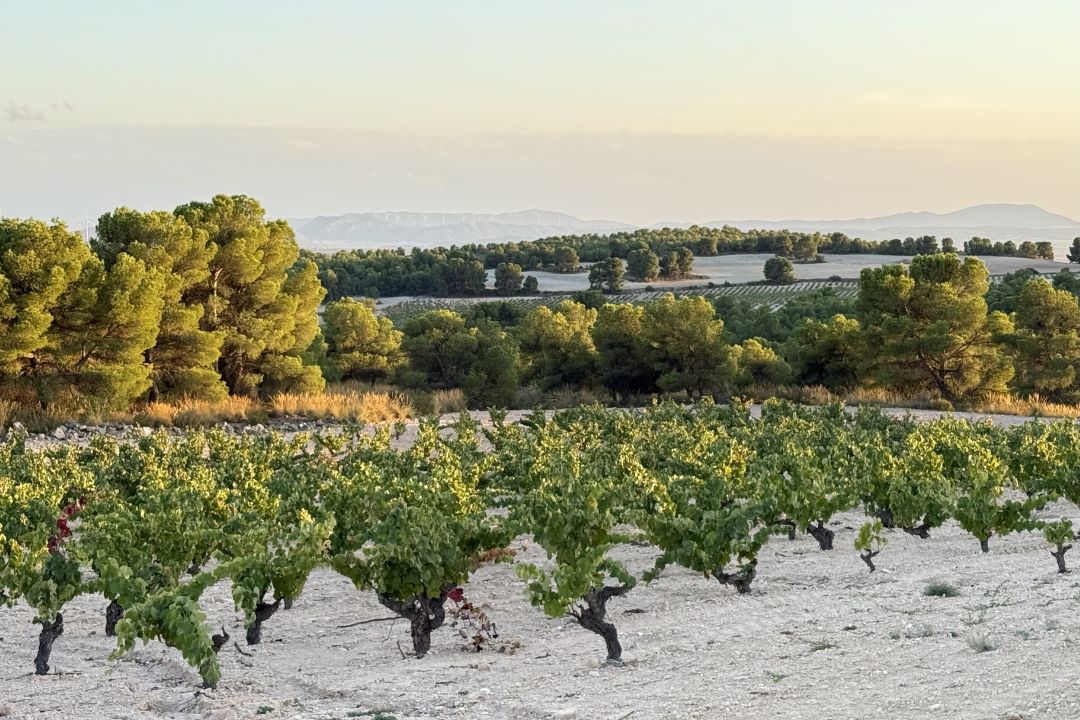
The vineyards between the Manchegan village of Fuente-Álamo and neighboring Murcia present a contrast of green foliage and white, calcareous soils rich in gypsum crystals.
Corpinnat Redefines Sparkling Wine
It’s hard to understand why Penedès can’t agree on the right path forward for their sparkling wines. Cava, Clàssic Penedès and several other categories share the spotlight, but it is clear that Corpinnat is becoming the most reliable designation in terms of quality.
Established as a shared private brand in the European Union (rather than a Denominación de Origen, or DO), the group of producers that go by the name Corpinnat is led by the major sparkling wine houses of Penedès, including Gramona, Recaredo, Llopart and Torelló. This year, I tasted with most of the 16 wineries involved, and excellence is obviously chief among the group’s priorities. In order to use the Corpinnat name, a producer must be organic and vinify the wine on site. There’s a limit on purchased grapes from outside the winery (51.5% in 2025) and a minimum agreed price (which was €0.90 per kilo this year). Minimum aging is 18 months on lees. The use of varieties such as Chardonnay and Pinot Noir is still permitted, but in declining quantities until they completely disappear in 2034, to be replaced by native varieties Xarel·lo, Macabeo and Parellada.
This report features some long-aged sparkling wines with delicate, nuanced profiles. While mild acidity is a hallmark of Penedès, it’s the chalky textures and ethereal personalities that set well-aged Corpinnats apart.

The modern underground cellar where Llopart crafts long-aged Corpinnats in Penedès.
Sumoll Against Climate Change
In an increasingly hot world, Catalunya and similar Mediterranean regions have a great opportunity to expand its horizons to include varieties that offer new flavors and are resistant to the ever-more extreme conditions. I continue to encounter more and more fascinating experiments that combine contemporary research with an eye to the past, with producers reconsidering the potential red grapes such as Sumoll, Mandó and Arcos (of which only a very few hectares had survived), as well as white varieties like Forcada and Picapoll.
Sumoll is a red variety with somewhat rustic tannins—similar to Nebbiolo—but delicate red fruit flavors. Strikingly, it has an average pH of 3.1, even when fully ripe, presenting a distinctive palate for a red: lean and energetic. Although not many have found the right balance as of yet, Bodega Pardas, L’Enclòs de Peralba and Can Sumoi are paving the way with reds that are light in body but boast plenty of energy and structure. Yielding wines with refreshing energy and volume in the mouth, the white grape Forcada shows just as much potential in both the still and sparkling categories. The Torres family and the Abadal winery are leading the charge to recover this variety (and others) at a significant scale.
The Magic of Xarel·lo
The second-most widely planted grape in Catalunya after Macabeo, Xarel·lo makes up the core of both sparkling and still wines in the region, with 10,500 hectares under vine (about 7,000 of which are in the Penedés DO). Aromatic with good body, it presents aromas of green apple and pear against a backdrop of Mediterranean herbs and prominent fennel undertones.
When French varieties grew popular in the 1980s and 1990s, as part of a broader effort to introduce “improving grapes,” wineries sought to replace Xarel·lo with Chardonnay, especially as a base for sparkling wines. This gave rise to a resistance movement that saw producers championing Xarel·lo and bottling it on its own from the mid-2000s onward. Xarel·lo received a significant boost from those producers who believed in its ability to yield quality still wines, sparkling wines and Brisats.
Today, the most interesting whites in the region are either pure Xarel·lo or blends based around it. The best aged whites I tasted for this report were also Xarel·lo, grown on calcareous soils. Readers should seek out the 2021 Can Sumoi Xarel·lo La Costa, the 2014 Pardas Pur Xarel·lo and the 2023 Finca Viladellops Tres Xarel·lo Selecció to get a feel for the variety’s potential in still wine.
Xarel·lo’s story is similar to that of other indigenous white varieties such as Malvasía de Sitges, Cariñena Blanca and Merseguera, which appear further south and lend character to Mediterranean wines. Pablo Calatayud at Celler del Roure said, “In the end, it turns out that the ‘improving’ grapes were the ones that were always here.”
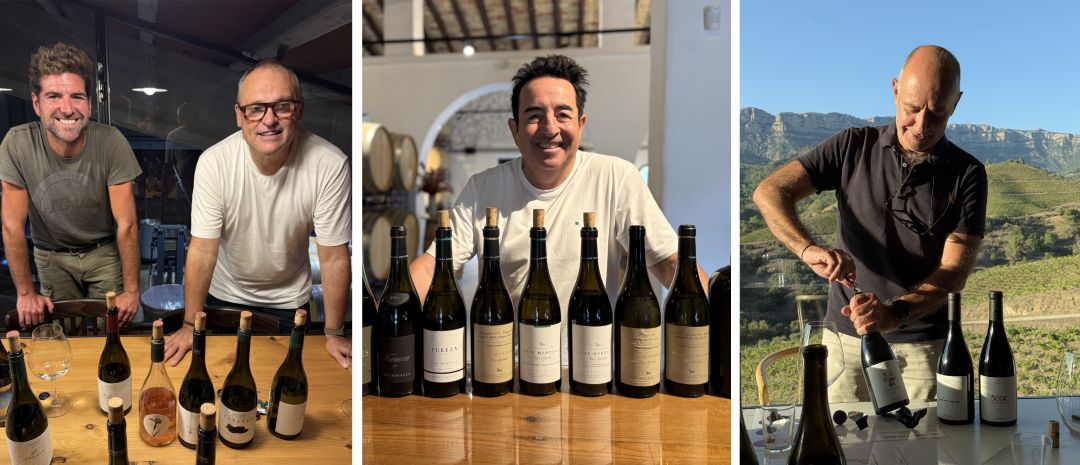
From left to right: Winemaker Modesto Arroyo and Josep Grau in Montsant; Pepe Mendoza at his Casa Agrícola winery in Alicante; Valentí Llagostera, co-founder of Mas Doix.
Brisat is the Old Orange
Catalunyan food expert Oriol Pérez de Tudela, who also makes wines in Tarragona, noted that Mediterranean whites were historically always Brisats, i.e., whites fermented with skins and stalks. Here, orange wines are far more than a trend—they are embedded within the region’s winemaking heritage.
Mediterranean producers have picked up on this idea. I tasted a number of wines that were macerated with skins to some degree. Today’s Brisats reflect a wide range of quality. Because the intense local sunlight affects the phenolic development in the skins, it takes a careful hand in the winery to regulate that intensity. The best Brisats I tasted for this report were made with Malvasía de Sitges and Xarel·lo, such as the 2022 Torre del Veguer Brisat Pur, the 2024 Herència Altés Llunari and the 2022 Vinyes del Tiet Perez Escabeces Velles.
Garnatxa and Cariñena: Priorat’s Dynamic Duo
Priorat is a magical place. The landscape is home to a charming mountain viticultural tradition of terraces and costers (i.e., sloping vineyards) on mostly slate soils, but more importantly, Priorat is a place where winegrowers really know their vines.
Where Priorat’s resurgence was initially driven by those “improving varieties” in the 1990s, today it is very much about paying homage to the historical Garnatxa and Cariñena varieties. Both adapt notably well to the high temperatures in summer and intense sun exposure. In the austere soils of Priorat, both Garnatxa and Cariñena manage to preserve vibrant acidity and give wines a talc-like texture. This structure is the hallmark of the region.
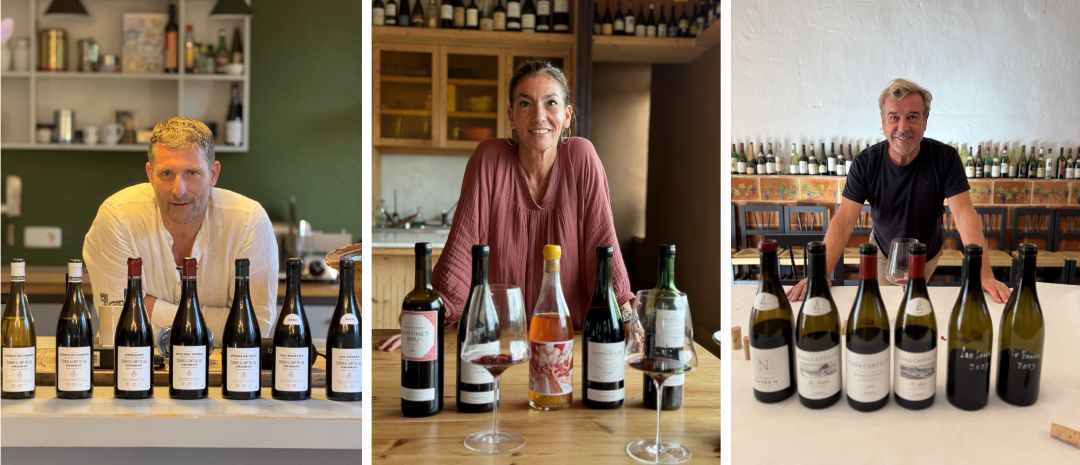
From left to right: Dominik Huber of Terroir al Limit in Priorat; Sara Pérez of Mas Martinet & Venus in Priorat; José María Vicente Sánchez of Casa Castillo in Murcia.
What makes these two varieties a dynamic duo is their complementary aromatics. Where Garnatxa at its best is pure vitality—expressed as notes of rose, cherry and blood orange—Cariñena has more heft and delivers plummy aromas that enhance its Mediterranean herbal tones. Combined, these varieties present serious complexity that rewards measured aging, although overuse of new wood and overexposure to oxygen in vinification and élevage can be detrimental.
Since the approval of the current classification system in 2017, Priorat has followed the Burgundian method of classifying its wines by village and area. It is interesting to note the contrast between the rounded richness of reds from Bellmunt and Gratallops and the silkier, nimbler versions from Poboleda and Scala Dei, the latter of which occasionally verge on ethereal. Priorat runs the whole gamut of possibilities. This report features wines that neatly fall into each category.
You can still find the ripe, potent, liqueur-like wines of previous eras, albeit to a much lesser degree—for instance, the 2023 Inici and the 2021 Perer Vi de Paratge—but there are also lighter reds such as the 2023 Terroir al Límit Les Manyes or the 2022 Nit De Nin Mas d'En Caçador. This raises an interesting question about the region: which style is the most representative of a modern Priorat? The terroir in Priorat supports this extreme stylistic diversity, showing the full range of what is possible with this type of fruit, concentration and texture. Priorat is a rich seam of delicious new discoveries.
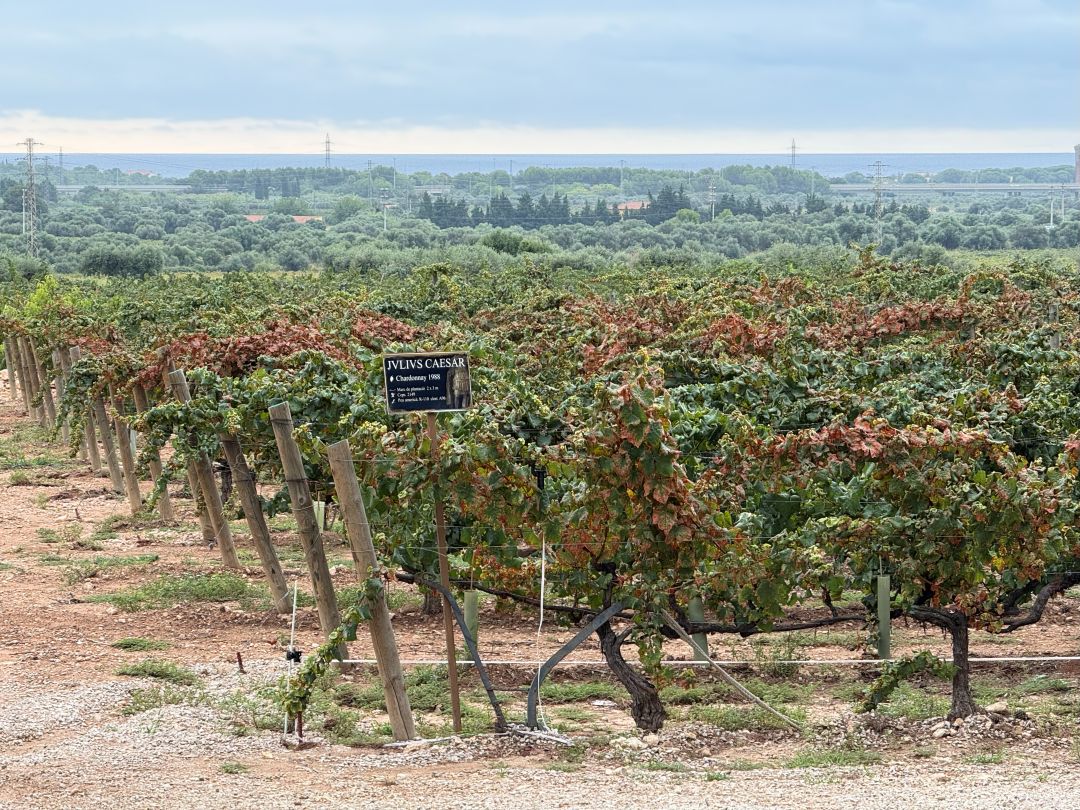
This harvested vineyard in Baix Penedès shows damage from green leafhoppers—a serious issue this year. The Mediterranean Sea is visible in the background.
Mosquito Verde
I visited Catalunya, Valencia and Alicante in the middle of harvest time. In Penedès and Tarragona, as well as in the Líber and Alforins valleys, vineyards were suffering from mosquitos verdes (green leafhoppers) which feed on vines’ sap. Some varieties were hit worse than others, but the damage was unmistakable on Chardonnay, Pinot Noir and Garnacha Tintorera: the leaves were brown, as though they’d been scorched, and some plants were stripped bare. If you touched a vine, a little green cloud of insects would lift off. The plague has exacerbated producers’ troubles, coming on top of low grape prices (which I’ll discuss below) and vines weakened by recent drought. The spread of organic methods has necessitated the search for organic pest control methods. It won’t be easy, and some already believe that the mosquitos verdes are here to stay.
The 2021-2024 Drought
The drought was particularly intense on Catalan shores, and many of the producers I spoke to were contemplating installing irrigation where possible. Even the most reluctant are considering it, as the very survival of the vineyards is at stake. The available data on the drought shows a wet 2020 cycle followed by far below average rainfall in 2021, 2022 and 2023, then a recovery in the spring of 2024. Conditions were truly dire—since 1920, there has only been one other drought of comparable intensity, between 2006 and 2008, and that one was shorter.
Vineyards in places like Penedès and especially Priorat suffered an acute lack of water. In the 2021-2022 cycle, there were periods as long as 106 days without rainfall. Higher than normal temperatures only exacerbated the effect—from May 2022 to December 2023, every month saw unusually high temperatures. Temperatures reached as high as 50°C (122°F) in Priorat.
The stress of these years is evident in the wines. The 2021 reds are concentrated but balanced, thanks to the water the plants had retained from the 2020 cycle. Most of the 2022s, in contrast, show signs of uneven ripeness and rustic tannins alongside marked concentration. In 2023, the producers who made wines pruned heavily in winter, leaving only half the buds, and the wines achieved good balance, though they are still more concentrated than usual. Relief came in 2024, but the reds still bear the scars of the previous three years. Two thousand twenty-five will hopefully mark a return to normalcy, as this year saw average rainfall and dry days brought normal temperatures. Only toward the end of the growing season, especially in Catalunya, did higher temperatures convince some producers to bring the harvest forward. For this reason, the DOQ will permit whites with less than 12% alcohol for the first time in its history.
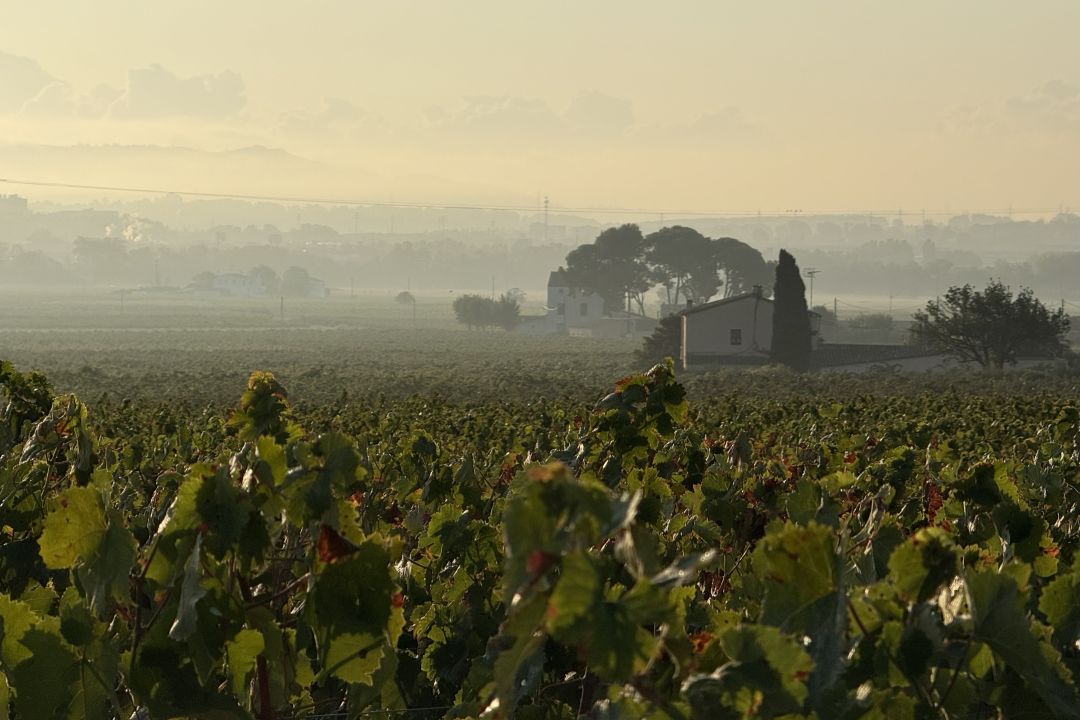
Morning mist rises over Familia Torres' Moneu vineyard after a night of rainfall.
Monastrell and Levante
Mourvèdre, Monastrell and Mataró are synonyms. Of all the reds in the Mediterranean, this is the variety that seems the most adaptable (aside from Garnacha, which is dominant in most of the rest of Spain). Monastrell isn’t especially widespread on the coast of Catalunya, but it becomes more prevalent as you head south toward Valencia and Alicante. Monastrell reigns supreme in Levante, with about 23,000 hectares under vine.
The image that best describes the vineyards of Levante is that of an archipelago, in which the islands have little in common beyond Monastrell. This year, I went on a brief but intense tour of the area, visiting vineyards and wineries in Utiel-Requena and Moixent (Valencia), the Vilalopó and Líber valleys, and some corners of Murcia between Jumilla and Fuente-Álamo (Castilla-La Mancha).
Said archipelago is a conglomeration of very white limestone and ferrous red clay that each lend a distinctive character to Monastrell. The former tightens the palate, while the latter gives it some muscle. All the wines here are solar (the region gets over 300 days of sun), but this grape’s magic lies in its ability to preserve its acidity even when very ripe. It also produces interesting notes of dark fruit and spice.
The best wines here are those that aren’t overly compacted or concentrated. I very much enjoyed Carlos Cerrón’s interpretation of the limestone vineyards of the area. “We look for fat grapes to produce looser, juicier palates that represent the distinctiveness of our parcels,” Cerrón said. Casa Castillo and Bodegas Mustiguillo produce a similar style of Monastrell thanks to their own painstaking work in the vineyard.
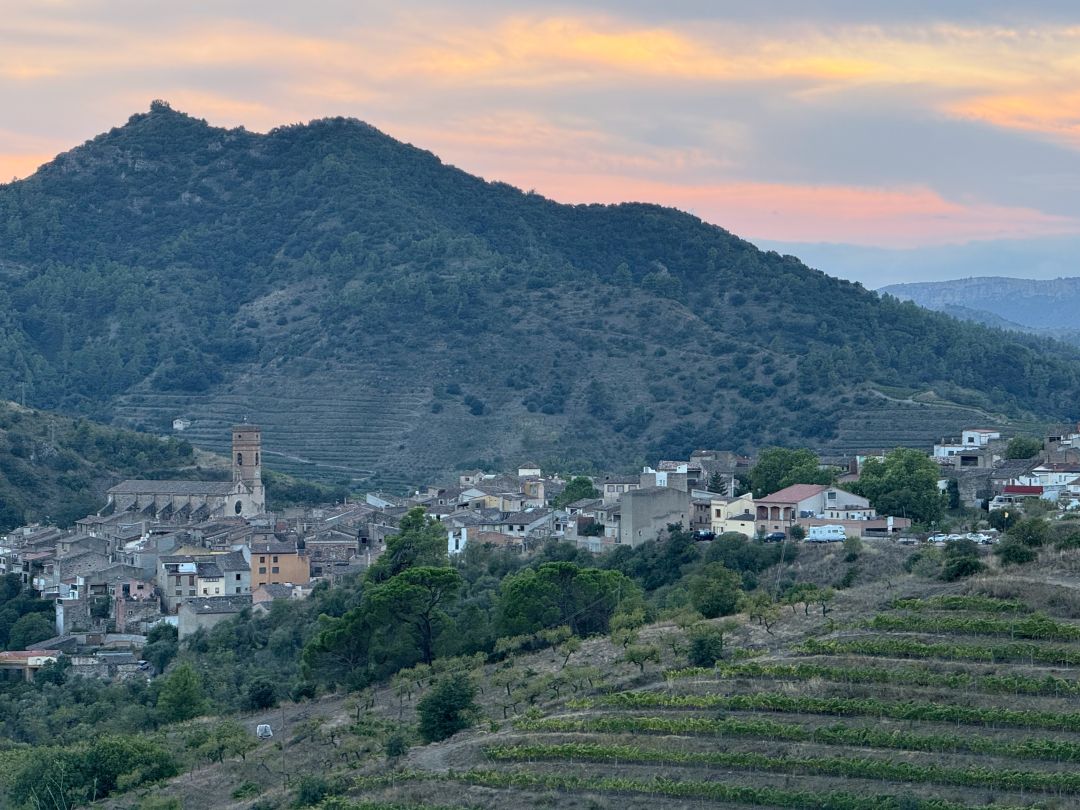
Vineyards climb the hillsides on all sides of Poboleda, a village in Priorat, a common sight in many towns throughout the region.
The Low Price of Grapes
Up and down the Mediterranean coast during harvest time, the price of grapes was a constant topic of conversation. I noted sharp variations in different areas, from €0.20 per kilogram for basic grapes in Penedès to €3 per kilogram in vineyards in Priorat and Montsant. In Penedès, all conversations about grape prices came to the same conclusion: between the drought and low prices this year, many small, family and weekend producers will have dropped out by the beginning of next year’s cycle. A storm appears to be brewing in a region with about 26,000 hectares of vine.
On the border between Castilla-La Mancha and Murcia, the situation was even worse. The cooperatives—to which almost everyone referred in the past tense, as though they were a failed model—sold grapes at such a low price that it required five decimal points, with varieties such as Airen costing €0.015025 per kilogram. Unless processes were highly automated and large-scale, the business just wasn’t viable.
Other Sun-Kissed Areas for Intrepid Palates
This report also includes fortified wines from Jerez and Murcia, as well as some Mediterranean sweet wines. The world of fortified, sweet and rancio wines is just as diverse as the still wines. AT Roca still has vermouths and rancios that date back to 1900, which visitors can taste directly from bulbous glass vessels. Similar experiences are available in Costers del Priorat and at Bodegas Abadal, but from casks and barrels that date back to the Spanish Civil War. After lengthy oxidation in wood, these wines deliver biting acidity and linger forever on the palate. Very few are available on the market, but more are available in the wineries, so when you visit, remember to inquire about tasting these rarities.
I tasted the majority of the wines for this report during my trip to Spain in September 2025, with follow-up tastings in my office in Buenos Aires.
© 2025, Vinous. No portion of this article may be copied, shared or redistributed without prior consent from Vinous. Doing so is not only a violation of our copyright but also threatens the survival of independent wine criticism.
You Might Also Enjoy
Gredos, Granite and Garnacha, Joaquín Hidalgo, October 2025
El Bierzo & Galicia: The Sil River Illuminates a Different Side of Spanish Wine, Joaquín Hidalgo, September 2025
The Diverse Villages of Rioja: A New Trend Emerges, Joaquín Hidalgo, May 2025
From Revolution to Evolution: The Garnatxas and Cariñenas of Priorat & Montsant, Joaquín Hidalgo, November 2024
The Rambunctious Catalan Mediterranean and Beyond, Joaquín Hidalgo, September 2024
JOAQUÍN HIDALGO | 25 NOVIEMBRE, 2025
Entre Catalunya y Levante, lo que llamaremos España Mediterránea, la abundante luz solar da lugar a tintos, blancos y espumosos de sorprendente intensidad y frescura. Un crisol de visiones distintas sobre lo que debería ser un vino de terruño regional, combinado con una amplia gama de variedades, un mareo de estilos y un orgullo ancestral por los sabores locales, convierte a la España Mediterránea en un excelente lugar para descubrir vinos inolvidables en paisajes igualmente singulares.
Para este informe, viajé desde el Empordà, en la frontera francesa, hasta Murcia, en el límite con Castilla-La Mancha, visitando 54 productores y catando más de 650 vinos que reflejan cómo el mar y los climas locales moldean esta región.
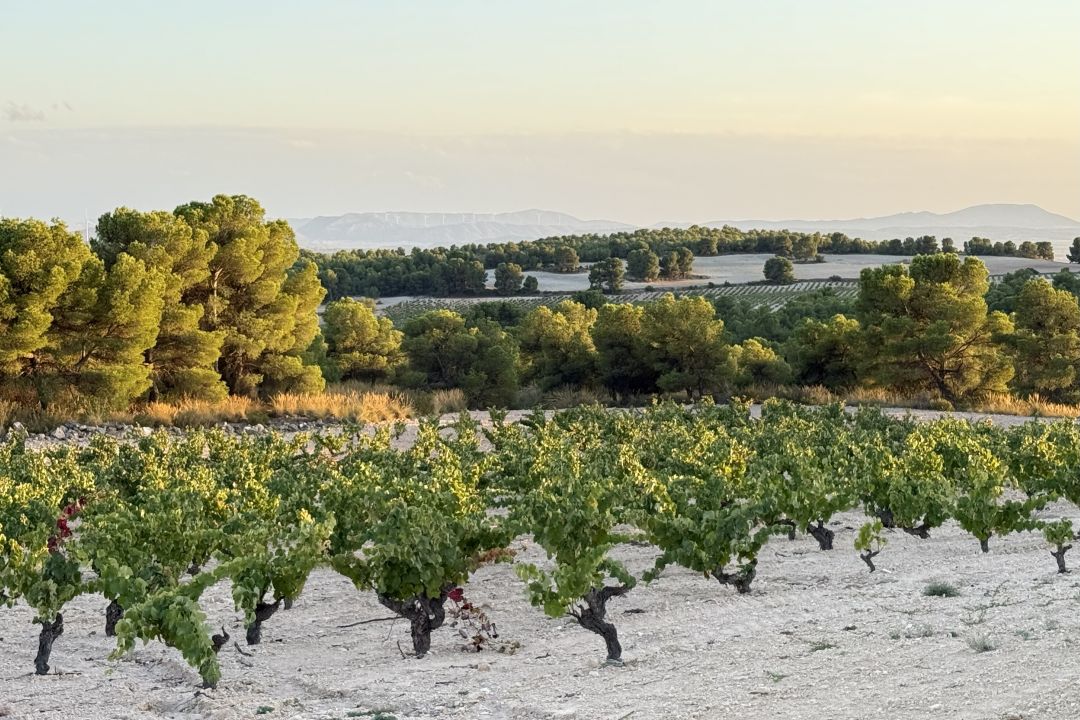
Una tarde a finales del viaje recorrí con Juanjo Cerrón los viñedos entre el pueblo manchego de Fuente-Alamo y los de la vecina Murcia. El paisaje bucólico del atardecer marca el contraste entre el verde del follaje y los suelos blancos, calizos, que en este sitio son ricos en cristales de yeso.
Corpinnat Redefine el Vino Espumoso
Cuesta entender por qué Penedès no logra ponerse de acuerdo sobre el camino adecuado para sus vinos espumosos. Cava, Clàssic Penedès y varias otras categorías comparten el protagonismo, pero es evidente que Corpinnat se está convirtiendo en la designación más fiable en términos de calidad.
Establecido como una marca privada compartida en la Unión Europea (más que como una Denominación de Origen, o DO), el grupo de productores que lleva el nombre Corpinnat está liderado por las principales casas de espumosos del Penedès, incluyendo Gramona, Recaredo, Llopart y Torelló. Este año, caté con la mayoría de las 16 bodegas implicadas, y la excelencia es claramente la mayor prioridad del grupo. Para utilizar el nombre Corpinnat, un productor debe ser orgánico y vinificar el vino en la propiedad. Hay un límite para la compra de uvas de fuera de la bodega (51,5% en 2025) y un precio mínimo acordado (que este año fue de 0,90 € por kilo). La crianza mínima es de 18 meses sobre lías. El uso de variedades como Chardonnay y Pinot Noir sigue estando permitido, pero en cantidades decrecientes hasta desaparecer por completo en 2034, siendo reemplazadas por las variedades autóctonas Xarel·lo, Macabeo y Parellada.
Este informe incluye algunos espumosos de larga crianza con perfiles delicados y matizados. Aunque la acidez moderada es una característica del Penedès, son las texturas calcáreas y las personalidades etéreas las que diferencian a los mejores Corpinnats envejecidos.
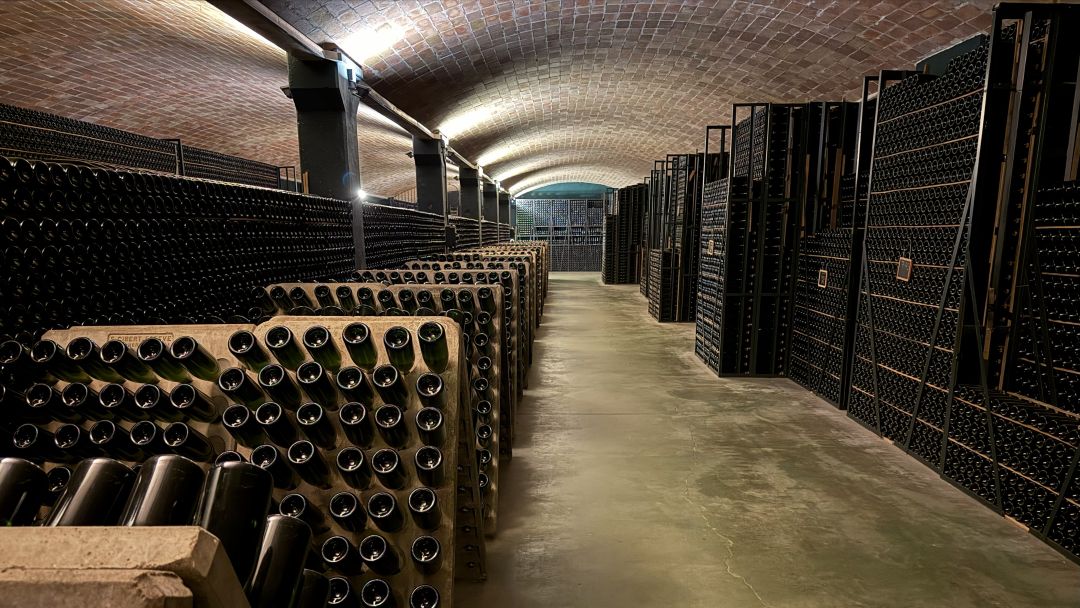
El Penedès abunda en cavas subterráneas para la cría de espumosos. En la foto se observa la moderna cava de Llopart, donde elaboran sus Corpinnats de larga crianza.
Sumoll Contra el Cambio Climático
En un mundo cada vez más cálido, Catalunya y otras regiones mediterráneas similares tienen una gran oportunidad de ampliar sus horizontes para incluir variedades que aporten nuevos sabores y sean resistentes a condiciones cada vez más extremas. Sigo encontrando experimentos fascinantes que combinan la investigación contemporánea con una mirada al pasado, con productores reconsiderando el potencial de variedades tintas como Sumoll, Mandó y Arcos (de la cual solo unas pocas hectáreas habían sobrevivido), así como de variedades blancas como Forcada y Picapoll.
Sumoll es una variedad tinta con taninos algo rústicos —similares a los del Nebbiolo— pero con delicados sabores de fruta roja. Sorprendentemente, tiene un pH promedio de 3,1 incluso cuando está completamente madura, lo que presenta un paladar distintivo para un tinto: esbelto y energético. Aunque no muchos han encontrado el equilibrio adecuado todavía, Bodega Pardas, L’Enclòs de Peralba y Can Sumoi están allanando el camino con tintos ligeros de cuerpo pero llenos de energía y estructura. Forcada, una variedad blanca que ofrece vinos refrescantes y voluminosos en boca, muestra un potencial igual de notable tanto en la categoría de vinos tranquilos como en la de espumosos. La familia Torres y la bodega Abadal lideran la recuperación a gran escala de esta variedad (y otras).
La Magia del Xarel·lo
La segunda variedad más plantada en Catalunya después de Macabeo, Xarel·lo es la columna vertebral tanto de los vinos espumosos como de los vinos tranquilos de la región, con 10.500 hectáreas plantadas (unas 7.000 en la DO Penedès). Aromático y con buen cuerpo, presenta aromas de manzana verde y pera sobre un fondo de hierbas mediterráneas y marcados matices de hinojo.
Cuando las variedades francesas se popularizaron en los años ochenta y noventa como parte de un esfuerzo más amplio por introducir “variedades mejorantes”, las bodegas buscaron reemplazar el Xarel·lo con Chardonnay, especialmente como base para espumosos. Esto dio lugar a un movimiento de resistencia que llevó a productores a defender el Xarel·lo y embotellarlo por separado desde mediados de los años 2000. El Xarel·lo recibió un impulso significativo gracias a quienes creían en su capacidad para producir vinos tranquilos, espumosos y Brisats de calidad.
Hoy, los blancos más interesantes de la región son o bien Xarel·lo puros o mezclas centradas en esta variedad. Los mejores blancos con crianza que caté para este informe también eran Xarel·lo, cultivados en suelos calcáreos. Los lectores deberían buscar el 2021 Can Sumoi Xarel·lo La Costa, el 2014 Pardas Pur Xarel·lo y el 2023 Finca Viladellops Tres Xarel·lo Selecció para apreciar el potencial de la variedad en vinos tranquilos.
La historia del Xarel·lo se asemeja a la de otras variedades blancas autóctonas como Malvasía de Sitges, Cariñena Blanca y Merseguera, que aparecen más al sur y aportan carácter a los vinos mediterráneos. Pablo Calatayud, de Celler del Roure, comentó: “Al final, resulta que las uvas ‘mejorantes’ eran las que siempre estuvieron aquí”.
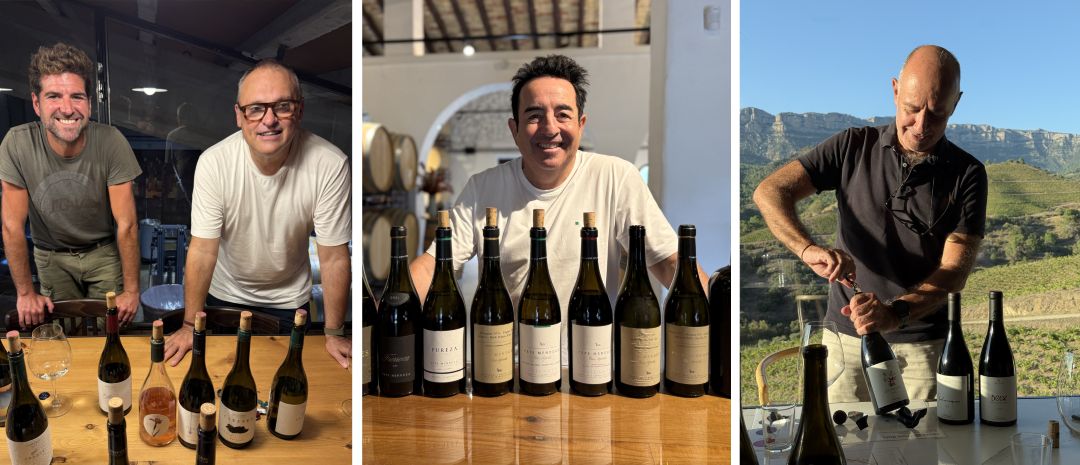
A la izquierda, y de blanco, Josep Grau, junto al enólogo Modesto Arroyo, en Montsant; al centro Pepe Mendoza en su bodega Casa Agrícola, Alicante; a la direcha, Valentí Llagostera, co-fundador de Mas Doix.
El Brisat es el Antiguo Orange
El experto catalán en gastronomía Oriol Pérez de Tudela, quien también elabora vinos en Tarragona, señaló que los blancos mediterráneos eran históricamente siempre Brisats, es decir, blancos fermentados con pieles y tallos. Aquí, los vinos naranjas son mucho más que una tendencia: están profundamente arraigados en la herencia vitivinícola de la región.
Los productores mediterráneos han retomado esta idea. Caté varios vinos macerados con pieles en mayor o menor grado. Los Brisats de hoy presentan un amplio abanico de calidad. Debido a que la intensa luz solar local influye en el desarrollo fenólico de las pieles, se requiere una mano muy cuidadosa en la bodega para regular esa intensidad. Los mejores Brisats que probé para este informe fueron elaborados con Malvasía de Sitges y Xarel·lo, como el 2022 Torre del Veguer Brisat Pur, el 2024 Herència Altés Llunari y el 2022 Vinyes del Tiet Perez Escabeces Velles.
Garnatxa y Cariñena: El Dúo Dinámico del Priorat
Priorat es un lugar mágico. El paisaje alberga una encantadora tradición vitícola de terrazas y costers (viñedos en pendiente) sobre suelos predominantemente de pizarra, pero más importante aún, Priorat es un sitio donde los viticultores conocen profundamente sus viñas.
Aunque el renacimiento del Priorat se vio inicialmente impulsado por aquellas “variedades mejorantes” en los años noventa, hoy se trata de rendir homenaje a las variedades históricas Garnatxa y Cariñena. Ambas se adaptan notablemente bien a las altas temperaturas de verano y a la intensa exposición solar. En los austeros suelos del Priorat, tanto Garnatxa como Cariñena logran conservar una acidez vibrante y dar vinos con una textura similar al talco. Esta estructura es la marca distintiva de la región.
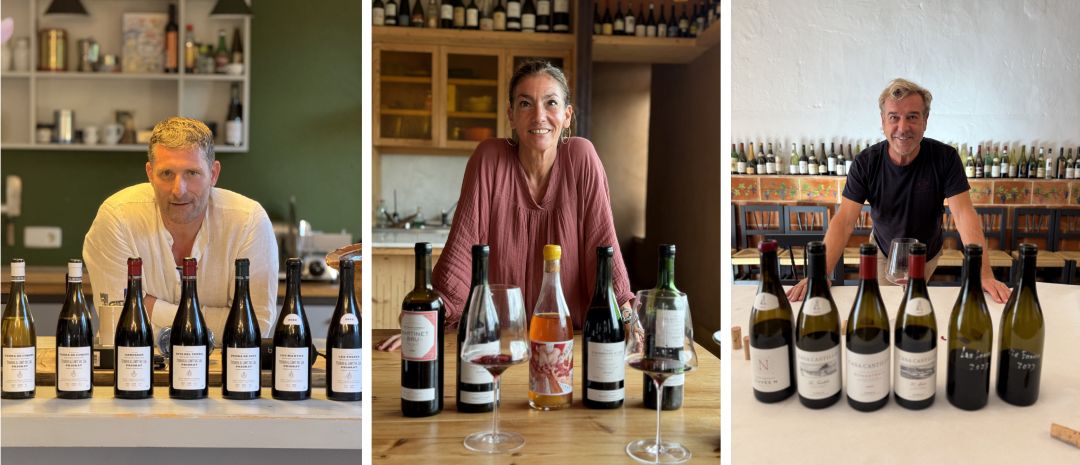
A la izquierda y centro, los productores de Priorat Dominik Hubert, de Terroir al Limit, y Sara Pérez de Mas Marinet & Venus; a la derecha, José María Vicente Sánchez de Casa Castillo, en Murcia.
Lo que convierte a estas dos variedades en un dúo dinámico son sus aromáticas complementarias. Donde la Garnatxa, en su mejor expresión, muestra una vitalidad pura —con notas de rosa, cereza y naranja sanguina—, la Cariñena ofrece mayor peso y aromas ciruela que realzan sus matices herbales mediterráneos. Combinadas, estas variedades presentan una complejidad seria que recompensa el envejecimiento cuidadoso, aunque el uso excesivo de madera nueva y la sobreexposición al oxígeno en la vinificación y crianza pueden resultar perjudiciales.
Desde la aprobación del sistema de clasificación actual en 2017, Priorat ha seguido el método borgoñón de clasificar sus vinos por pueblo y zona. Es interesante notar el contraste entre la riqueza redondeada de los tintos de Bellmunt y Gratallops, y las versiones más sedosas y ágiles de Poboleda y Scala Dei, estas últimas a veces rozando lo etéreo. Priorat abarca toda la gama de posibilidades. Este informe incluye vinos que encajan claramente en cada categoría.
Aún se pueden encontrar los vinos maduros, potentes y de estilo licoroso de épocas anteriores, aunque en mucha menor medida —por ejemplo, el 2023 Inici y el 2021 Perer Vi de Paratge—, pero también existen tintos más ligeros como el 2023 Terroir al Límit Les Manyes o el 2022 Nit de Nin Mas d'En Caçador. Esto plantea una pregunta interesante sobre la región: ¿qué estilo es el más representativo del Priorat moderno? El terruño del Priorat permite esta diversidad estilística extrema, mostrando todo lo que es posible con este tipo de fruta, concentración y textura. Priorat es una veta rica de deliciosos descubrimientos.

El mosquito verde este año fue un asunto serio. En la foto se observa un viñedo ya vendimiado en la zona de Baix Penedès –al fondo se ve el Mediterráneo–, donde las hojas acusan la acción del mosquito. Lejos de ser una excepción, este viñedo nada más que un ejemplo.
Mosquito Verde
Visité Catalunya, Valencia y Alicante en pleno periodo de vendimia. En Penedès y Tarragona, así como en los valles del Líber y los Alforins, los viñedos sufrían por los mosquitos verdes (cicadélidos) que se alimentan de la savia de las vides. Algunas variedades se vieron más afectadas que otras, pero el daño era inconfundible en Chardonnay, Pinot Noir y Garnacha Tintorera: las hojas estaban marrones, como si hubieran sido chamuscadas, y algunas plantas estaban desnudas. Si tocabas una vid, se levantaba una pequeña nube verde de insectos. La plaga ha agravado los problemas de los productores, sumándose a los bajos precios de la uva (de los que hablaré más adelante) y a viñas debilitadas por la reciente sequía. La expansión de los métodos orgánicos ha obligado a buscar estrategias de control de plagas también orgánicas. No será fácil, y algunos ya creen que los mosquitos verdes han llegado para quedarse.
La Sequía de 2021-2024
La sequía fue especialmente intensa en las costas catalanas, y muchos de los productores con los que hablé estaban considerando instalar riego donde fuera posible. Incluso los más reacios lo piensan ahora, ya que está en juego la supervivencia misma de los viñedos. Los datos disponibles muestran un ciclo húmedo en 2020, seguido de precipitaciones muy por debajo del promedio en 2021, 2022 y 2023, y luego una recuperación en la primavera de 2024. Las condiciones fueron verdaderamente extremas: desde 1920 solo ha habido otra sequía comparable, entre 2006 y 2008, y aquella fue más corta.
Los viñedos de zonas como Penedès y especialmente Priorat sufrieron una falta de agua aguda. En el ciclo 2021–2022 hubo períodos de hasta 106 días sin lluvias. Las temperaturas más altas de lo normal agravaron aún más la situación: de mayo de 2022 a diciembre de 2023, todos los meses registraron temperaturas inusualmente elevadas. Las temperaturas alcanzaron hasta 50 °C en el Priorat.
El estrés de estos años es evidente en los vinos. Los tintos de 2021 son concentrados pero equilibrados, gracias al agua que las plantas habían retenido del ciclo 2020. La mayoría de los 2022, en cambio, muestran signos de madurez desigual y taninos rústicos junto a una marcada concentración. En 2023, los productores que elaboraron vinos con poda invernal severa —dejando solo la mitad de las yemas— lograron buenos equilibrios, aunque aún son más concentrados de lo habitual. El alivio llegó en 2024, pero los tintos todavía muestran las cicatrices de los tres años anteriores. Con suerte, 2025 marcará un regreso a la normalidad, ya que este año vio lluvias promedio y días secos con temperaturas normales. Solo hacia el final de la temporada de crecimiento, especialmente en Catalunya, las temperaturas elevadas convencieron a algunos productores de adelantar la vendimia. Por esta razón, la DOQ permitirá por primera vez vinos blancos con menos de 12% de alcohol.

La añada 2025 estuvo marcada por las lluvias exactas. Con todas las blancas en bodega, la mañana en que visité el viñedo de Moneu de Familia Torres se levantaba cierta niebla de la lluvia caída la noche anterior.
Monastrell y Levante
Mourvèdre, Monastrell y Mataró son sinónimos. De todas las tintas del Mediterráneo, esta es la variedad que parece más adaptable (aparte de Garnacha, dominante en gran parte del resto de España). Monastrell no es especialmente común en la costa de Catalunya, pero se vuelve más prevalente a medida que uno se dirige hacia el sur, rumbo a Valencia y Alicante. Monastrell reina en Levante, con unas 23.000 hectáreas plantadas.
La imagen que mejor describe los viñedos del Levante es la de un archipiélago, en el que las islas tienen poco en común más allá del Monastrell. Este año realicé una gira breve pero intensa por la zona, visitando viñedos y bodegas en Utiel-Requena y Moixent (Valencia), los valles del Vinalopó y el Líber, y algunos rincones de Murcia entre Jumilla y Fuente-Álamo (Castilla-La Mancha).
Dicho archipiélago es una mezcla de caliza muy blanca y arcilla roja férrica, cada una aportando un carácter distintivo al Monastrell. La primera tensa el paladar, mientras que la segunda le da músculo. Todos los vinos aquí son solares (la región recibe más de 300 días de sol), pero la magia de esta uva radica en su capacidad para preservar la acidez incluso cuando está muy madura. También produce interesantes notas de fruta negra y especias.
Los mejores vinos aquí son aquellos que no están excesivamente compactados o concentrados. Disfruté mucho la interpretación que hace Carlos Cerrón de los viñedos calcáreos de la zona. “Buscamos uvas gordas para producir paladares más sueltos y jugosos que representen la singularidad de nuestras parcelas”, dijo Cerrón. Casa Castillo y Bodegas Mustiguillo producen un estilo similar de Monastrell gracias a su propio y meticuloso trabajo en el viñedo.
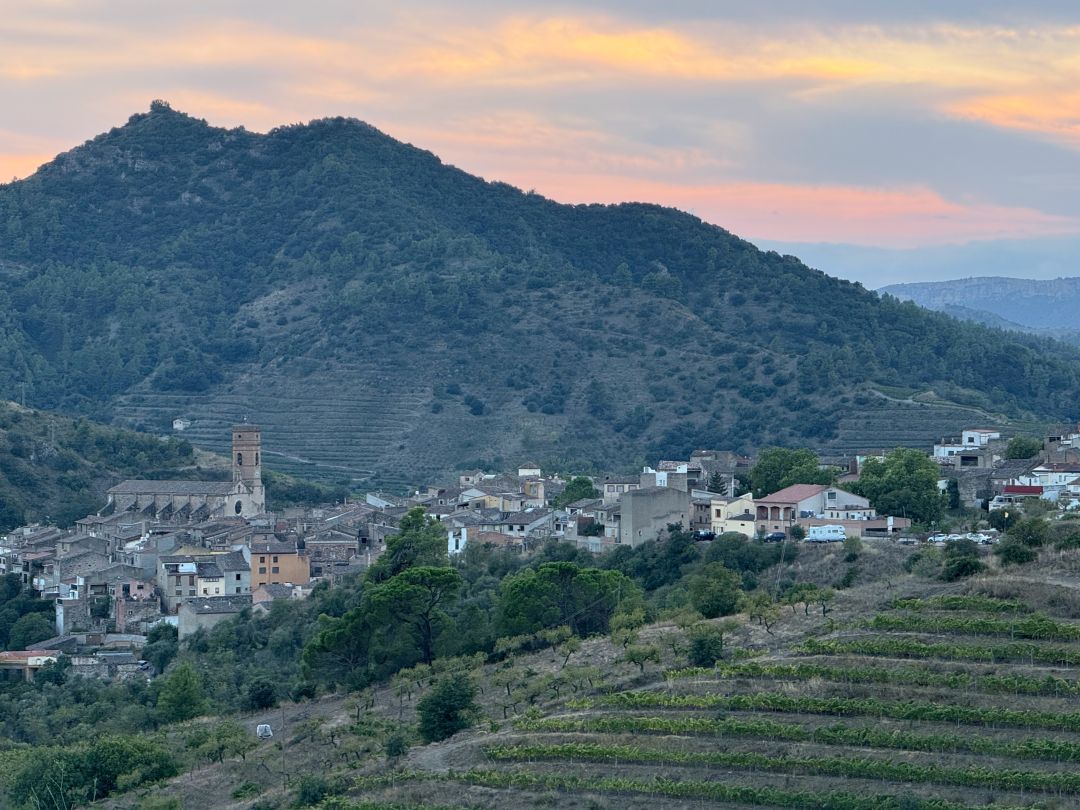
Atardece en el pueblo de Poboleda, en Priorat. Es impresionante ver cómo la viña trepa a cuatro costados del pueblo. Lejos de ser una anomalía, es lo que uno ve en todos los rincones de la región.
El Bajo Precio de la Uva
A lo largo de la costa mediterránea durante la vendimia, el precio de la uva fue un tema constante de conversación. Noté variaciones pronunciadas entre diferentes zonas, desde 0,20 € por kilo para uvas básicas en el Penedès hasta 3 € por kilo en viñedos de Priorat y Montsant. En el Penedès, todas las conversaciones sobre precios de uva llegaban a la misma conclusión: entre la sequía y los precios bajos este año, muchos pequeños productores familiares y de fin de semana habrán abandonado para el inicio del próximo ciclo. Parece que se avecina una tormenta en una región con unas 26.000 hectáreas de viñedo.
En la frontera entre Castilla-La Mancha y Murcia, la situación era aún peor. Las cooperativas —a las que casi todos se referían en pasado, como si fueran un modelo fracasado— vendían uvas a precios tan bajos que requerían cinco decimales, con variedades como Airén a 0,015025 € por kilo. A menos que el proceso fuera altamente automatizado y a gran escala, el negocio simplemente no era viable.
Otras Áreas Bañadas por el Sol para Paladares Intrépidos
Este informe también incluye vinos generosos de Jerez y Murcia, así como algunos vinos dulces mediterráneos. El mundo de los vinos generosos, dulces y rancios es tan diverso como el de los vinos tranquilos. AT Roca aún conserva vermuts y rancios que datan de 1900, que los visitantes pueden catar directamente de recipientes de vidrio bulbosos. Experiencias similares están disponibles en Costers del Priorat y en Bodegas Abadal, pero de toneles y barricas que datan de la Guerra Civil Española. Tras largas oxidaciones en madera, estos vinos ofrecen acidez punzante y un final eterno en el paladar. Muy pocos están disponibles en el mercado, pero hay más accesibles en las bodegas, así que cuando las visites, recuerda preguntar por estas rarezas.
Caté la mayoría de los vinos de este informe durante mi viaje a España en septiembre de 2025, con catas de seguimiento en mi oficina en Buenos Aires.
© 2025, Vinous. Ninguna parte de este artículo puede ser copiada, compartida o redistribuida sin el consentimiento previo de Vinous. Si se incurriese en ello, no solo se viola nuestro copyright, sino que también se amenaza la supervivencia de la crítica independiente de vinos.
También Podrías Disfrutar
Gredos, Granitos y Garnacha, Joaquín Hidalgo, octubre 2025
El Bierzo y Galicia: El río Sil ilumina otra cara del vino español, Joaquín Hidalgo, septiembre 2025
Los Diversos Pueblos de Rioja: Emerge una Nueva Tendencia, Joaquín Hidalgo, mayo 2025
De la Revolución a la Evolución: Las Garnatxas y Cariñenas de Priorat & Montsant, Joaquín Hidalgo, noviembre 2024
El Agitado Mediterráneo Catalán y Más Allá, Joaquín Hidalgo, septiembre 2024
Show all the wines (sorted by score)
- Abadal
- Agrícola de Garriguella
- Agrícola Falset-Marça
- Alicia i Josep Viticultors
- Alta Alella
- Alvarez Duran Priorat
- Álvaro Domecq
- Alvear
- Andre Ortiz
- André Ortiz
- Anima Mundi
- Anna Espelt
- AT Roca
- Av Bodeguers
- Azimut
- Bodega Frontonio
- Bodega Mustiguillo
- Bodegas Atalaya
- Bodegas El Nido
- Bodegas Habla
- Bodegas Hispano+Suizas
- Bodega Sierra Salinas
- Bodegas Juan Gil
- Bodegas Pinord
- Bodegas Volver
- Buil & Giné
- Can Rafols dels Caus
- Can Sumoi
- Can Valles
- Casa Castillo
- Casa de la Ermita
- Casa Gran del Siurana
- Celler Arché Pagés
- Celler Cooperatiu D'Espolla
- Celler Credo
- Celler de Capçanes
- Celler de les Aus
- Celler del Roure
- Celler Domenys
- Celler Krypta
- Celler La Vinyeta
- Celler Martí Fabra
- Celler Mas Doix
- Celler Mas Pòlit
- Celler Montpicolis
- Cellers Avgvstvs Forvm
- Cellers de Scala Dei
- Celler Vall Llach
- Cien y Pico
- Clos D'Agon
- Clos i Terrasses
- Clos Mogador
- Clos Pachem
- Clos Salanca
- Coca i Fitó
- Companyia Viticola Sileo
- Costers del Priorat
- Devinssi
- Ego Bodega
- Ego Bodegas
- Empordàlia
- Esencia Wines
- Espectacle
- Espelt Viticultors
- Familia Nin Ortiz
- Familia Torres
- Ferre i Catasus
- Ferrer Bobet
- Finca Bacara
- Finca la Font de Jui
- Finca Viladellops
- Genium Celler
- Gramona
- Gratavinum
- Hacienda El Carche
- Herència Altés
- Heretat Baltà de Cela
- Jean Leon
- J. Fortuny Fabregas
- Joan Grill
- Joan Segura Pujadas Vins i Caves
- Jorge Ordóñez Málaga
- Josep Grau & Fills
- Josep Grau Viticultore
- Josep Masach
- Juvé & Camps
- La Conreria d'Scala Dei
- L'Enclòs de Peralba
- Les Vinyes Forer Massard
- Llopart
- LoAlto
- Marco Abella
- Mas D'en Blei
- Maset
- Mas Llunes
- Mas Martinet Viticultors
- Merum Priorati
- Oliveda
- Oliver Viticultors
- Pagès Entrena S.L.
- Pagos Casa Gran
- Pardas
- Parés Baltà
- Pasanau Germans
- Pepe Mendoza
- Perelada
- Portal del Priorat
- Quadrum Wine Company
- Raventós i Blanc
- Recaredo
- Sabaté i Coca
- S'Alou
- Samsara Priorat
- Sangenis i Vaqué
- Sarah i René Viticultors
- Sara i René Viticultores
- Soques
- Stratum Wines
- Suriol
- Terroir al Límit
- Terroir Sense Fronteres
- Tocat de l'Ala
- Torelló
- Torre del Veguer
- Venus Universal
- Viader
- Vicente Gandía
- Vinicola del Priorat
- Vino Sexto Elemento
- Vins el Cep
- Vins Pepe Raventós
- Vinyes del Tiet Pere (Oriol Pérez de Tudela)
- Vinyes d'Olivardots
- Vinyes D'Olivardots
- Viticultors Mas d'en Gil
